![[cease photo-30k]](cease_d.gif)
Environmental Threats
- Total Radiation Dose
- Radiation Dose Rate
- Surface Dielectric Charging
- Deep Dielectric Charging
- Single Event Effects
![[logo-4k]](cease1.gif)
Compact Environmental Anomaly Sensor Space Radiation Alarm |
Today's space systems demand high performance and reliability. However, satellites operate in a hostile environment, bombarded by ionizing radiation from a variety of sources. Ionizing radiation damages electronic components and systems, with consequences ranging from minor performance degradation to catastrophic system failure. Cost effective and simple ways to reduce this risk both in the design and operation of the spacecraft are needed. Amptek offers the answer - a multipurpose easily integrated, environmental hazard sensor package, the Compact Environmental Anomaly SEnsor (CEASE). 1
![[cease photo-30k]](cease_d.gif) |
Environmental Threats
|
Spacecraft operators are responsible for preventing degradation in performance and failure of space-borne systems. With real-time warnings that the environment is likely to cause anomalies, operators can alter spacecraft operations to minimize risk to their systems. Today, space "weather" forecasts serve as these warnings. But the forecasts do not provide the real-time local conditions required to take corrective action.
Anomalies or failures do occur, and the tools to understand their causes are needed. Space environmental effects must be isolated from other causes of system failures. When operators have to pinpoint the definitive cause of a spacecraft anomaly, real-time, in situ monitoring is needed. Without it, time, money and even satellites are lost. With such monitoring, operators can modify operations during hazardous conditions, predict performance loss and end of life, and launch replacement satellites if necessary.
CEASE is a small, low power instrument that provides operators with fully processed, real time, in situ measurements and autonomously generated warnings of the space radiation environment threats. CEASE reports these threats to the host spacecraft:
The primary CEASE output to the spacecraft, updated once per minute, is a 10-byte Engineering Data packet quantifying the threat levels associated with those space environment hazards. Appropriate action may then be taken by the spacecraft or its operators to mitigate risk.
With its suite of sensors and sophisticated onboard data processing, CEASE is an extremely flexible stand-alone diagnostic instrument. CEASE is a solution to the problem of space environmental monitoring for both operational and experimental spacecraft. It is the primary instrument chosen by the US military for this task. There are two versions of CEASE available to provide the necessary monitoring (Table 1). CEASE II includes an additional sensor to better characterize the surface charging in geosynchronous orbits.
| Table 1 - Summary of CEASE Properties | ||
|---|---|---|
| Property | CEASE I | CEASE II |
| Size | 4.0 x 4.0 x 3.2 " | 4.0 x 5.1 x 3.2 " |
| Mass | 1.0 kg | 1.3 kg |
| Power* | 1.5 Watts | 1.7 Watts |
| Standard Interface | RS422 or MIL-STD-1553B | RS422 or MIL-STD-1553B |
| Telemetry (minimum) | 10 bytes per 60 sec | 10 bytes per 60 sec |
| Diagnostic Sensors | Lightly Shielded Dosimeter Heavily Shielded Dosimeter SEE Detector Particle Telescope | Lightly Shielded Dosimeter Heavily Shielded Dosimeter SEE Detector Particle Telescope Electrostatic Analyzer |
| *Power requirements can vary for non-standard interfaces. Power ratings for RS422 interface. | ||
As electronic components are exposed to ionizing radiation dose, they suffer progressive cumulative damage. Once a tolerable dose for a given component is exceeded, its performance will degrade and the component may even fail catastrophically. The failure mechanism can depend on the total radiation dose, the radiation dose rate, or the type of particles responsible for the dose. For example, some components are particularly sensitive to a displacement damage, a specific effect caused primarily by protons rather than electrons.
With its dosimeters, CEASE measures both the integrated radiation dose (rads) and very high short term radiation dose rates (rads/hr). The particle populations primarily responsible for this are >5 MeV protons and >1 MeV electrons. The conditions at geosynchronous altitudes and in high inclination orbits following a major solar flare and in the inner radiation belt present the most hazardous ionizing radiation doses for spacecraft. CEASE also measures the integrated surface radiation dose that shortens the life of solar cells.
Very large energy deposition events create sufficient charge in an electronic device to alter its logic state, either temporarily (bit flip) or permanently (latch-up). The results are known as Single Event Effects (SEEs). SEEs can result in corrupted data processing, commanding, and telemetry. The worst cases can cause system failures. Typically, SEEs are induced by >50 MeV proton or high energy heavy ions. The SEE hazard is greatest in the inner radiation belt. CEASE measures large energy deposition events and returns information on the probability of encountering SEEs on orbit.
Dielectric charging occurs when insulating materials absorb incident electrons. Surface charge can build on dielectric materials exposed to the space environment, leading to arc discharges. These discharges, in turn, generate significant noise transients that upset or damage sensitive on-board electronics. Lower energy electrons drive the surface charging. Additionally, charge can build on dielectric materials (e.g. shielded electronics, coaxial cables) in the interior of a spacecraft. This phenomenon is known as deep dielectric charging and is caused by high energy electrons. Both types of dielectric charging are predominantly a hazard in high altitude and geosynchronous orbits. CEASE monitors both surface and deep dielectric charging with its particle telescope while CEASE II includes an electrostatic analyzer to better characterize the lower energy particle environment relevant to surface charging at geosynchronous altitudes.
CEASE processes the collected sensor data to quantify the environmental threat levels due to the hazards discussed above. These threat levels are provided in eight Hazard Registers (Table 2). If a Hazard Register exceeds its threshold, CEASE then sets a corresponding Warning Flag. The Hazard Registers and Warning Flags are CEASE's primary output to the spacecraft.
| Table 2 - CEASE Hazard Registers | |||
|---|---|---|---|
| Name | Acronym | Description | Typical Dynamic Range |
| Lightly Shielded Dose | LSD | Mission integrated radiation dose behind 0.08" of Al | 0.2 to 118 krad |
| Heavily Shielded Dose | HSD | Mission integrated radiation dose behind 0.25" of Al | 0.1 to 59 krad |
| Lightly Shielded Dose Rate | LSR | Radiation dose rate over the last minute behind 0.08" of Al | 0.04 to 27 rads/hr |
| Heavily Shielded Dose Rate | HSR | Radiation dose rate over the last minute behind 0.25" of Al | 0.04 to 27 rads/hr |
| Surface Dose | SUD | Solar panel damage parameter: "effective 1 MeV electron fluence" | 1.8 x 1013 to 5.6 x 1016 electrons/cm2 |
| Single Event Effect | SEE | Register value is proportional to SEE probability | 0 to 15 events/minute |
| Surface Dielectric Charging | SDC | Electron flux responsible for surface dielectric charging (50 < E < 250 keV) | 5.0 x104 to 2.3 x 109 electrons/cm2-sec |
| Deep Dielectric Charging | DDC | Electron flux responsible for deep dielectric charging (E > 250 keV) | 4.2 x103 to 1.9 x 108 electrons/cm2-sec |
CEASE provides its data on the environmental hazards in the form of one of three data packets. The Engineering Data packet is the minimum amount of information required to assess the environmental threat. The History Data contains time histories over 72 hours of selected critical data, to be used in conjunction with the Engineering Data. CEASE can provide the highest level of detail in space environment data in the Science Data packet.
The 10-byte Engineering Data packet contains the Hazard Registers, the Warning Flags, and CEASE state-of-health data. Operators can use these data in a variety of ways. The spacecraft can read the packet on a regular interval. Alternatively, Engineering packets can be read by the spacecraft only as needed, such as in the event of an anomaly. At a minimum, the spacecraft processor, or its operators on the ground, need only check a single byte in the Engineering packet, which contains the eight Warning Flags. If no flags are set ON, the processing of the rest of the packet may be skipped. If one or more Warning Flags are set, then the rest of the packet can be processed to determine the nature and severity of the threat. Appropriate action may then be taken by the spacecraft or its operators to avoid problems.
If CEASE has issued a warning, the spacecraft operators can then request the relevant History Data blocks from the instrument. The History Data provide more detail about the environmental threats, particle fluxes and radiation doses than the Engineering Data. The History Data consists of the previous 72 hours of data stored in a ring buffer. Each 15-minute data segment is contained in a 52-byte packet.
The most detailed space environment data available from CEASE are available in the Science Data packet. This packet contains the raw count rates and the raw spectra collected from the sensor suite. These are the data from which the Engineering Data are derived. The frequency of this Science output can be tailored to the specific needs of the mission but must be selected prior to instrument fabrication. The standard Science packet is 56 bytes, but this can also be adjusted to meet the mission requirements. Science Data are most appropriately obtained from CEASE on the initial satellites in a constellation or on experimental spacecraft.
The U.S. Department of Defense has flown CEASE on the TSX-5 and STRV-1C missions which launched in the second half of 2000 and will fly CEASE on the Defense Support Program (DSP) operational spacecraft to launch in the first quarter of 2001.
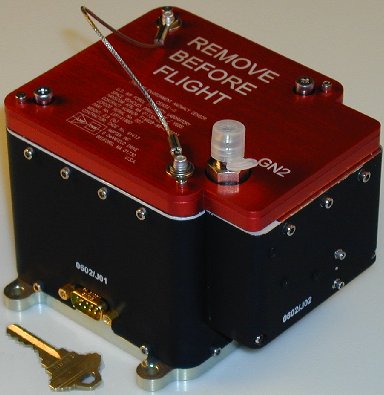 CEASE II With ESA and Cover On |
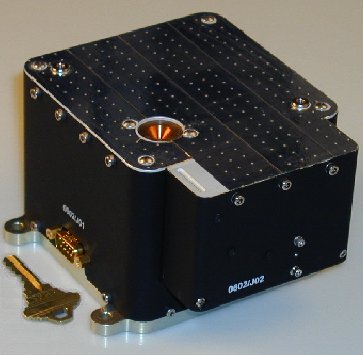 CEASE II With ESA |
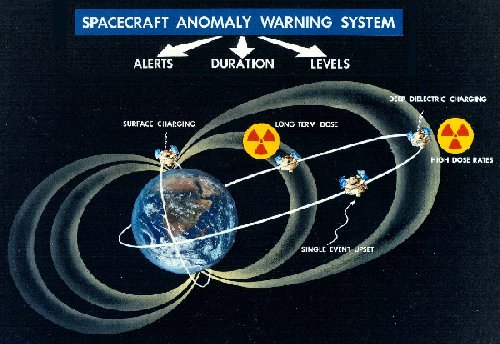
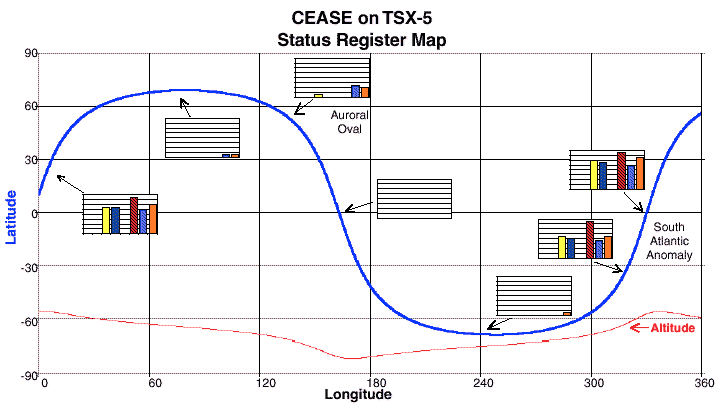
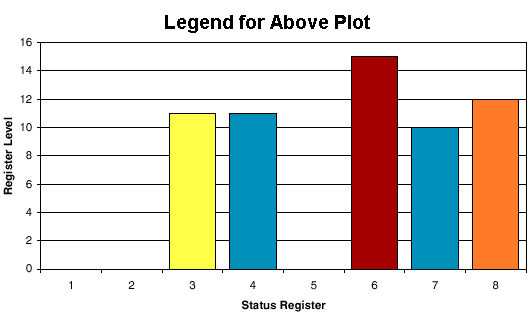
| SR# | Name | Description |
| 1 | Lightly Shielded Dose | Mission integrated radiation dose behind 0.08" of Al |
| 2 | Heavily Shielded Dose | Mission integrated radiation dose behind 0.25" of Al |
| 3 | Lightly Shielded Dose Rate | Radiation dose rate over the last minute behind 0.08" of Al |
| 4 | Heavily Shielded Dose Rate | Radiation dose rate over the last minute behind 0.25" of Al |
| 5 | Surface Dose | Solar panel damage parameter: "effective 1 MeV electron fluence" |
| 6 | Single Event Effect | Register value is proportional to SEE probability |
| 7 | Surface Dielectric Charging | Electron flux responsible for surface dielectric charging (50 < E < 250 keV) |
| 8 | Deep Dielectric Charging | Electron flux responsible for deep dielectric charging (E > 250 keV) |
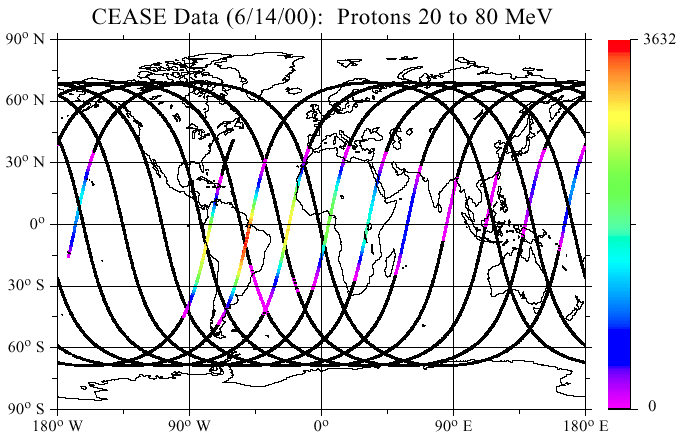
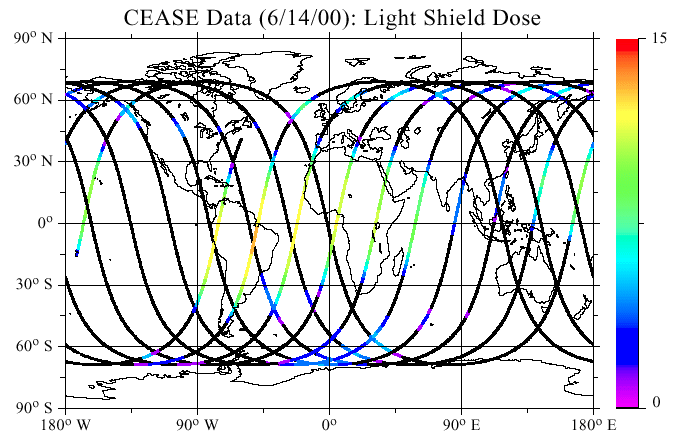
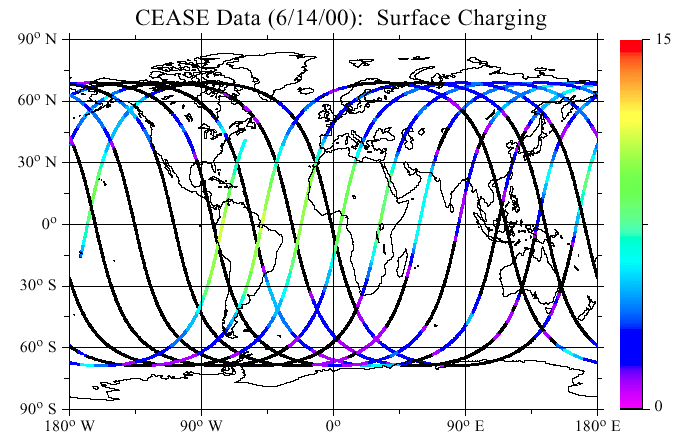
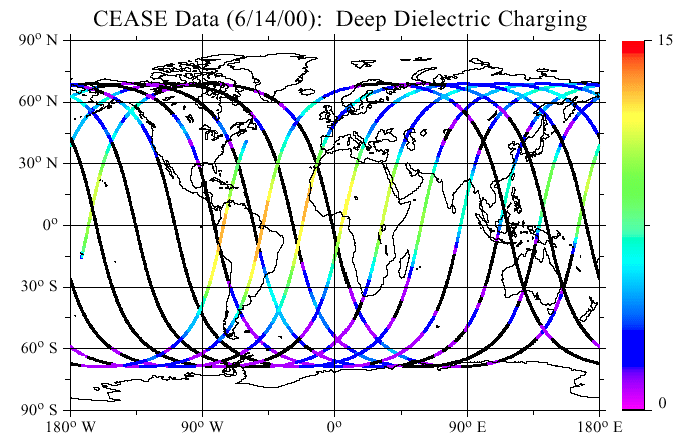
Cease Flight Data in PDF (923k).
Amptek has a long and distinguished track record in the manufacture of space instrumentation.
Mission examples include: DMSP, TIROS, CRRES, NEAR and APEX. Current off-the-shelf Amptek
sensors measure spacecraft charging, thermal and suprathermal, and high energy particles.
In addition, Amptek provided the X-ray Detector on the Mars PATHFINDER Mission.
High reliability front end electronics from Amptek have contributed to the success of many missions,
including: GALILEO, CASSINI, GIOTTO, AXAF, SUISEI, CLUSTER, SOLAR, GEOTAIL, SOHO, WIND and AMPTE.
Read the Amptek Company Profile for more information on Amptek's space mission history.
To learn more about CEASE, please contact us at:
Amptek, Inc.
6 De Angelo Drive, Bedford MA 01730
Tele: +1 781-275-2242 Fax: +1 781-275-3470
sales@amptek.com
Reference: 1 Dichter, B.K, et. al., "Compact Environmental Anomaly Sensor (CEASE): A Novel Spacecraft Instrument for In-Situ Measurement of Environmental Conditions", IEEE Trans. Nucl. Sci., Vol 45, No. 6, p. 2758, December 1998.
CEASE Summary in PDF format (4 pages - 53k)
Click below for an 18 page full technical description of CEASE
CEASE Full Specifications and Technical Description in PDF format (18 pages - 182k)
Revised Febraury 7, 2001